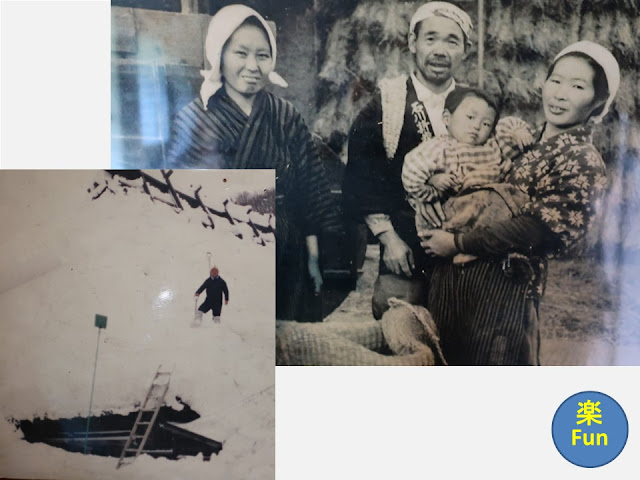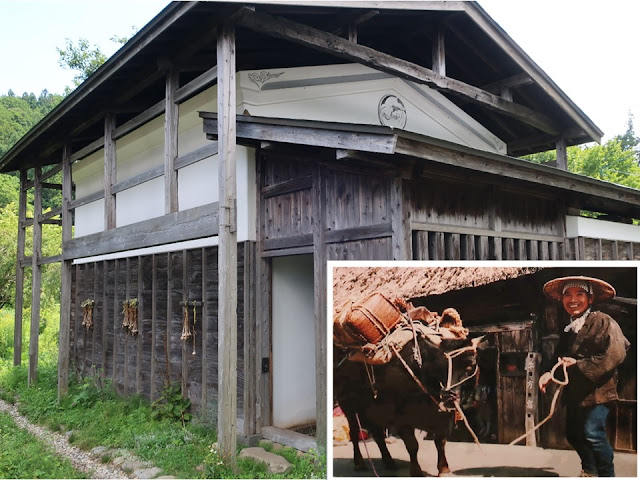A particular inn, which was built around early 19th century, still remains by Chikuni kaidou (Salt Road in central Japan). Six cattle carried salt and so on from seaside to inland cities, and a man (cattle-driver) led them. The driver and cattle stayed at the cattle-driver-inn; it is a sole one in existence along the road. We can feel their time in the inn.
千国街道(塩の道、糸魚川と松本を結ぶ街道)で輸送に携わった牛方や牛、歩荷が寝泊まりした建物が残っています。19世紀初期の建築と考えられ、旧街道沿いに現存する唯一の建物だそうです。牛方さんや歩荷(牛が歩けない冬に荷物を背負って歩いた人たち)のニオイを感じられます。The large entrance door for cattle has a small one for people in it.
牛が入る大きな扉に引き戸が取り付けられて(内蔵されて)います。
There is a large earthen floor inside the door. Cattle stayed at the stable on the left and drivers stayed at the opposite side.
土間が広く、左が牛が泊まった馬屋、反対側が牛方が泊まったスペースです。
Five or six cattle stayed at the stable above. Mangers are hung. There were stables and were storages to keep loads on the opposite side of the road.
馬屋には、牛を5~6頭入れました。飼葉桶が吊されています。道の向かい側には、牛小屋や鞍置き場がありました。
A driver stayed on the shelf and looked at his cattle, which were his important partners. I could know his feeling. A driver led six cattle. Staff told me that one cattle stayed in the inn and others did the other stable.
牛方は、馬屋の牛の様子を見ながら泊まったといわれています(左下はパンフレットの写真)。牛は相棒ですね。牛方一人で牛六頭を連れてあるきました。職員さんによると一頭はこの建物に、他の五頭は別棟に泊めたということでした。左下の絵の場所に来たかったのですが、ついに実現!
There are a stove and a fireplace (irori) in a kitchen. They cooked while eating. It’s good!
台所では、竈だけでなく囲炉裏でも料理します。煮ながら食べるのですね。
It is written that the room was used as a lobby. There is also a fireplace. Guests dried clothes and chatted there. A wooden weaving machine is exhibited. Worn out clothes were torn and were weaved again. Cloth was valuable back then.
こちらはロビーに当たると説明されている茶の間です。服を乾かす場、会話の場でした。障子の前では、古布を裂いて織る「ぼろ織り」が展示されています。使い古した服を裂いて生地を作ります。布は貴重でした。
The photo (upper right) was taken in late autumn of early 1950s. They had strong life force, I’m sure. Spiritual happiness is much important than material wealth! They have to remove snow on the roof. It’s not an easy place to live.
右上は昭和20年代後半・晩秋の写真です。「生きてる」っていう感じですね。物質的な豊かさより、精神的な豊かさが大切です、よね。左は雪下ろし。ここ今でも冬季通行止め区間です。
At the innermost guestroom, there are signatures of actresses and notebooks. Half of writers are foreigners. Some Japanese wrote the smell of the inn brought them back to old memories; those were similar to grandma’s house.
奥の座敷(客間)には、女優さんのサインなども展示されています(右下)。半分近くが外国人の記載です。一方、入場者用のノート(破線内)には、何人かの日本人が「ニオイが懐かしい」と記していました。そうだったのですね。
In the storehouse, photos and everyday goods are displayed. A storehouse of salt was moved to this site, too.
土蔵では写真や民具が展示されています。塩蔵も移築されています。
Chikuni kaidou (Salt Road)、千国街道(塩の道)
Do you know what the hole of the stone is? It’s used to hold a rope of cattle while taking a break.
近くの親坂には、休憩中に牛をつなぐ穴をあけた「牛つなぎ石」があります。
Chikuni kaidou (Salt Road) goes through mountain foots, because there were risks of floods beside the river. Bears appear, so I walked on a festival day (3rd of May). Two thousand and five hundred walkers attended in 2024.
千国街道(塩の道)は、水害を避けてか川の横ではなく、山すそを進みます。熊が怖いので5月3日の塩の道祭りで歩きました。2500人(2024年)が参加する人気イベントです。
Otari village fully support the event. The organizer gave me Japanese towel and a passport (upper left), although the admission fee was free.
村を挙げてイベントを運営しています。通行手形と記念品の手ぬぐいをいただきました(左上)。参加費無料なのに恐縮です。
Visited in July, 2024
Official website: https://www.vill.otari.nagano.jp/www/contents/1001000000195/index.html
(in Japanese), accessed in September, 2024
Previous post (museum in the same village which is on Salt Road): Chikuni
checkpoint and Chikuni local museum、千国番所と千国の庄史料館
Next post (museum on the highway which linked Matsumoto and Nagano): Hijiri museum、聖博物館















Comments
Post a Comment